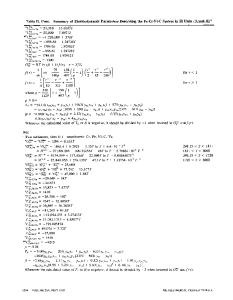Thermodynamic Assessment and Calculation of the Ti-Al System
- PDF / 897,099 Bytes
- 10 Pages / 597 x 774 pts Page_size
- 27 Downloads / 430 Views
I.
INTRODUCTION
T H E Ti-A1 system is an important basic system for multicomponent alloy systems which are of interest for the development of high-temperature ordered materials. Despite its importance, the phase relationships in this system were subject to many modifications in the recent past, [35,42-44,47,511 partially due to differences in impurity levels and the interpretation of microstructures. 1461Major discrepancies were concerned with the extension of the (aTi) field with respect to the temperature, t35~42'44,5~1These modifications are also reflected by the various calculations published in the literature. [18,25,34-36,38,391 Recent experimental examinations of the phase relationships in the Ti-A1 system have established many of the phase boundaries in question with sufficient accuracy. 142-44'47's1~ Since the accuracy of the thermodynamic description of a binary system is crucial for the prediction of ternary and higher order phase diagrams, a new thermodynamic description of the Ti-A1 system is developed here. The equilibrium phases in the Ti-A1 system are: the disordered solution phases, liquid, hcp-(aTi), bcc-(flTi), and fcc-(A1), and the ordered intermetallic compounds, Ti3AI (a2), which has an ordered hexagonal close-packed (hcp) superlattice structure, TiA1 (30, and TiA13, both of which have an ordered face-centered cubic (fcc)-based superlattice structure. The accurate phase relationships in the range between TiA1 and Ti3A1 are still subject to discussions in literature, due to the occurrence of longperiod fcc-based superstructures. 1471 II. HISTORY OF CALCULATIONS OF THE TI-AL SYSTEM Previous calculations of the Ti-A1 system used a variety of different models to fit the experimental phase diagram. Kaufman and Nesor I~8,25~used very simple descriptions in their calculation, the disordered solution U.R. KATTNER, Research Associate, University of WisconsinMadison, is Guest Scientist with the National Institute of Standards and Technology, Gaithersburg, MD 20899. J.-C. LIN, formerly with the University of Wisconsin-Madison, is Staff Scientist with ALCOA Technical Center, ALCOA Center, PA 15069. Y.A. CHANG, Distinguished Professor, is with the Department of Materials Science and Engineering, University of Wisconsin-Madison, Madison, WI 53706. Manuscript submitted November 21, 1991. METALLURGICAL TRANSACTIONS A
phases were described as quasi-regular solutions, and the intermetallic compounds Ti3A1, TiA1, and TiAI3 were assumed to be stoichiometric. Within the limitations of the model descriptions used, the general features of the then accepted phase diagram were reproduced. In a partial calculation of the system, Murray t351used the subregular model to describe the disordered solution phases and assumed TiAl3 to be stoichiometric. However, no comparison between the calculated and experimental phase boundaries was given. Gross e t a / . p61 calculated the Tirich part of the system (
Data Loading...











